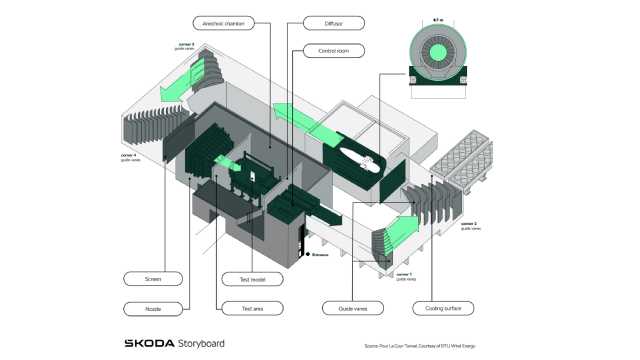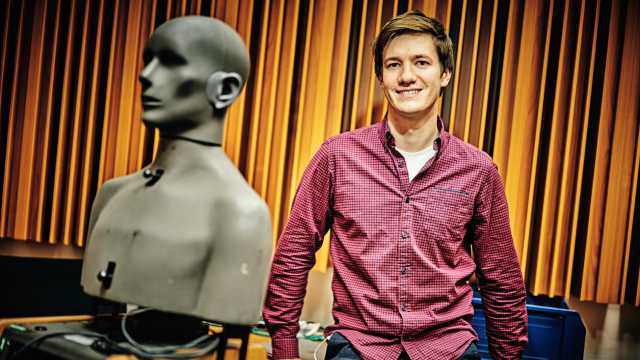ŠKODA aeroacoustics: how to eliminate noise while driving
Creating quiet and comfortable cars has always been a priority for ŠKODA; with electric cars the challenge becomes even more difficult: their natural quietness makes audible even the smallest noises.
All cars, even the best and most modern, generate a variety of sounds and noises. Electric vehicles are very quiet compared to an internal combustion engine, but they still make noises, especially as speed increases, when tire noise and aerodynamic noise get louder. From about 100 km/h, it is the aerodynamic noise that is most noticeable, and it is in this area that ŠKODA engineers have been focusing on for a long time to achieve better and better results.
The noise caused by airflow is the subject of a discipline called aeroacoustics: "We test the cars in an aeroacoustic tunnel where air is blown at them as if they were driving; we can change the air speed and turn the vehicle to assess the effect of a side wind", explains Filip Nováček from ŠKODA Technical Development.

Accurate measurements
The tunnel measurements are more accurate than those that can be made on the road, since they are not subject to external influences that change the data and can be reproduced exactly. "We can try out various alternatives and be confident that we are measuring the effect accurately", Nováček adds. ŠKODA has many facilities and laboratories for acoustic measurements, but for aeroacoustic testing it uses specialist sites across Europe.
During the tests, the experts measure the entire production car: "It has to be evaluated what is happening in the interior, so a prototype or a partial model, for example with only the bodywork, is not enough", Nováček resumes. The test takes place in a soundproof wind tunnel: the car is 'hit' by a closed air circuit that allows the sounds caused by the airflow to be measured.

Simulating Hearing
Inside the car, a "measuring head" is placed on each seat; this is a device that includes a series of microphones capable of simulating how a human hears. There are also acoustic cameras, which are dozens of tiny microphones linked to a video camera that are pointed at the car from the outside. In this way, the source of any sound can be identified in the image.
Once the vehicle is positioned, a powerful fan moves the air, but it is different from that in a conventional wind tunnel: it is positioned further away from the car to minimize the effect of the noise it generates on the measurements.
Cleaning the air
The circulating airflow is directed by guide vanes located at each of the four corners of the tunnel: in this way, passive noise is absorbed and the air takes the desired direction. Before entering the measuring area, the air flows through rectifier screens, which unify the airflow and eliminate swirling. Next, the air flow is accelerated by a nozzle, which ensures uniformity in distribution.
At this point the accelerated air enters the test area and, before it is pushed again by the fan completing the cycle, passes through a cooling surface to return to the optimum temperature by removing the heat generated in the process.
All kinds of noise
Acoustic comfort inside cars is not just about airflow. ŠKODA has two state-of-the-art acoustic measuring chambers with cylindrical dynamometers to measure the overall noise of a vehicle by simulating driving on different surfaces. In this test, not only the noise generated by the engine (including exhaust noise in cars with internal combustion engines) is measured, but also other sounds emitted by each individual component while driving.
ŠKODA conducts driving tests in all types of weather conditions, in its own laboratories - including the Quality Testing Polygon, which is a test track that reproduces different road conditions and various types of obstacles - and in specialized laboratories around the world.

Electric silence
Electric cars make the work of acoustics specialists even more important: "Internal combustion engines mask a lot of sounds, but electric cars are so quiet that even the slightest noise will stand out. This, consequently, increases the acoustic requirements of all vehicle components: drivers may be distracted or even think something is wrong with the car when in fact everything works perfectly", Nováček concludes.
While in most cases engineers try to eliminate noise, there is an intentionally generated sound in electric cars, which is the sound that vehicles have to make when traveling at low speed to alert pedestrians of their presence. Developing this kind of sound is a real science, and the ŠKODA Enyaq iV family SUV has its own original sound to alert pedestrians to the presence of the moving car.
Source: ŠKODA
VGI | Responsible OU: VP | Creation date: article date | Class 9.1
